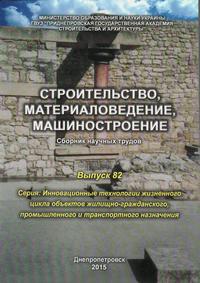Caracteristics of design of clothing retaining walls in complicated soil conditions
Keywords:
the clamping retaining wall, a complicated terrain topography, planting, creation of landscape compositions, reinforcement rebar with a screw profile and the coupling, computer modeling, sequence of loading, the stress-strain state, a configuration and heAbstract
Purpose. The analysis of opportunities of use of strengthening of sloping ground for planting and creating of landscape compositions, determination of advantage of their use in the existing environment of the city and requirements to retaining wall structural design for effective planting. Methodology. Computer modeling applying soil FE of LIRA SAPR 2014 software. Results. In case of insufficient bearing capacity of a sloping ground, for structural design of the retrofitted or completely repaired structures should be discussed their reinforcing and updating on request of the modern city which expediency should be confirmed by feasibility study. It is obvious that the choice of the effective structural solution of the clamping retaining walls is possible only on the basis of careful calculations taking into account geotechnical conditions of a foundations and construction of such structures. Complexity of such calculations and installation is that it is necessary to consider a set of various factors: real stratification of soil and sequence of loading on the basis; complicated geometry of a construction site, already built (existing) structures and a terrain topography; nonlinear properties of soil bases (work often outside a linear stage: slipping between layers, deformations at the large pulling-out loadings, etc.) ; an assessment of the loads arising in structural design at uneven settlements. Fully the accounting of the given factors is possible only with use of numerical methods by consideration of spatial models for interaction of the clamping retaining wall and the soil bases. Scientific novelty. The clamping retaining wall has the following advantages: 1. Construction of such wall possible for any configuration and height of the terrain; 2. The material consumption for construction of such wall is more rational. 3. Construction of such wall doesn't require large space. 4. Allows to experts variety of opportunities for creating unique architectural forms along the length of work space. Practical importance. Three types of zones of a complicated terrain are allocated, where possible effective use of the clamping retaining wall: city zone, a zone with negative anthropogenic impact and industrial zone.References
1.Rekomendatsii for use in reinforced concrete structures effective types of reinforcing rods. - M .: NIIZhB USSR State Construction Committee, 1987. – 47р. 2. Copyright certificate the USSR. №1830405. Butt joint of precast concrete elements. / Gigineishvili D.Y, Veryuzhsky Y.V., Gal'chenko N.G, Puzyrenko A.G, Matkov N.G; 1990. 3. Veryuzhsky J.V. Application of numerical-analytical method for building solutions to contact problems of calculating the clutch armature with concrete. New experimental research and methods of calculation of reinforced concrete structures // Veryuzhsky J.V, Gigineishvili D.Y, Sudakov G.N. Coll. Scien. tr. - M .: NIIZhB State Construction Committee of the USSR, 1989. – 199p. 4. Tkachenko T.N. Alternative types of industrial greenery planting/Tkachenko T.N., Savenkova S.V. // Sci-tech and business perception of reforms in construction and housing: theses. III Intern. Conf. (12.04-13.04.2012) / Makeyevka, Donbas National Academy of Civil Engineering and Architecture. - 2012. - CH.I. - p. 211-214 5. Tkachenko T.N. Alternative types of industrial greenery planting/Tkachenko T.N., Savenkova S.V. // Geographic and geoecologic research in Ukraine and adjacent lands. – Simferopol: DIAYPI, 2013. – T.1. – P.117-121. 6. Computer models of designs / Gorodetsky AS, Evzerov I. D .: KIEV "facts", 2007. - 394 p. 7. Komp'yuternі Tehnologії proektuvannya metalevih konstruktsіy. /Barabash M.S., Kozlov S.V., Medvedenko D.V. -K .: of NAU, 2012. - 572 p. 8. Examples for the calculation and design "LIRA 9.6" / Bogovis V.E., Genzersky Y.V., Geraymovich Y.D., Kutsenko D.V., Kutsenko A.N., Medvyedenko D.V., Slobodian YA.E ., Titok V.P. – K.; By the "fact", 2008. - 200 p.
Downloads
Issue
Section
License
Редакція Видання категорично засуджує прояви плагіату в статтях та вживає всіх можливих заходів для його недопущення. Плагіат розглядається як форма порушення авторських прав і наукової етики.
При виявлені у статті більш ніж 25% запозиченого тексту без відповідних посилань та використання лапок, стаття кваліфікується як така, що містить плагіат. У цьому випадку стаття більше не розглядається редакцією, а автор отримує перше попередження.
Автори, в статтях яких повторно виявлено плагіат, не зможуть публікуватися в усіх журналах Видавництва ДВНЗ «Придніпровська державна академія будівництва та архітектури».
Автори, які публікуються у цьому журналі, погоджуються з наступними умовами:
- Автори залишають за собою право на авторство своєї роботи та передають журналу право першої публікації цієї роботи на умовах ліцензії Creative Commons Attribution License, котра дозволяє іншим особам вільно розповсюджувати опубліковану роботу з обов'язковим посиланням на авторів оригінальної роботи та першу публікацію роботи у цьому журналі.
- Автори мають право укладати самостійні додаткові угоди щодо неексклюзивного розповсюдження роботи у тому вигляді, в якому вона була опублікована цим журналом (наприклад, розміщувати роботу в електронному сховищі установи або публікувати у складі монографії), за умови збереження посилання на першу публікацію роботи у цьому журналі.
- Політика журналу дозволяє і заохочує розміщення авторами в мережі Інтернет (наприклад, у сховищах установ або на особистих веб-сайтах) рукопису роботи, як до подання цього рукопису до редакції, так і під час його редакційного опрацювання, оскільки це сприяє виникненню продуктивної наукової дискусії та позитивно позначається на оперативності та динаміці цитування опублікованої роботи (див. The Effect of Open Access).

